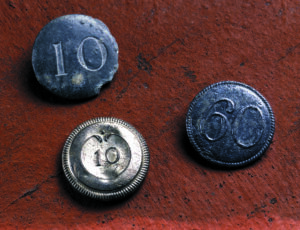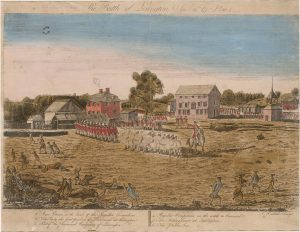

In the course of otherwise routine historic research, occasionally a previously unknown and unlooked for piece of information comes to light. Such is the case of the stabbing of Lt. James Hamilton of the 10th Regiment at Michilimackinac in the summer of 1773. This previously unknown (to us at Mackinac, at least) incident came to light while reviewing the voluminous correspondence of Frederick Haldimand, who served as governor of Quebec from 1778 to 1786. Within these pages, now held by the British Museum, is the account of the violent incident at Michilimackinac in 1773. Haldimand received the original letters since he was serving at the temporary commander in chief of British forces in North America at the time.
On July 31, 1773, Capt. John Vattas, the commanding officer of the detachment of the 10th Regiment at Michilimackinac, took depositions from Lt. James Hamilton and several other soldiers in the immediate aftermath of the incident. Hamilton, assigned to Vattas’ company, accused a Sergeant Dagg of Captain Robert Dalway’s company of stabbing him with a bayonet and attempting to murder him. In his deposition, Hamilton related that he went to Dagg’s house to confront the sergeant’s wife about a chicken she had supposedly stolen from him. After demanding the bird’s return, Hamilton reported that “Mrs. Dagg made use of provoking language to him, which obliged him to give her one or two kicks, and some strokes.” Mrs. Dagg ran outside “screeching,” so Hamilton started to make his way towards his own home. Once outside, Hamilton “saw Serjeant Dagg running up to him with great violence, with a drawn bayonet in his hand.” The lieutenant claimed that Dagg “made a lunge at the center part of his body,” but Hamilton twisted out of the way and into his own back yard, receiving a 2.5 inch cut near the “bottom of his belly” in the process. Hamilton’s memory was less clear about exactly what he said next, but he cried out “damn your blood, will you stab me?” or words to that effect. Dagg apparently “swore by God he would run any gentleman through that would use his wife so.” Convinced that Dagg intended to strike again and kill him, Hamilton ran inside his house. He waited a short time before reporting the incident to Vattas.


The depositions of the other soldiers added more details about the incident. These men, all likely part of the guard detail, were relaxing in and around the guardhouse when Mrs. Dagg ran outside screaming. Corporal John Newton was sitting on a bench near the guardhouse door with Sergeant Dagg, who was hemming a piece of stamped linen or cotton. Hearing his wife’s scream, Dagg ran towards his house, dropping the fabric on the ground. Cpl. Newton swore he did not see Dagg draw his bayonet, but upon returning to the guardhouse he saw Dagg attempting to put his bayonet back into its scabbard, and the corporal heard him say that “by heavens I have fixed myself.” John New reported that he was sitting on another bench near the guard room door when he heard a “great noise.” New saw Dagg jump up and run around the corner of Hamilton’s garden, so he followed the sergeant. New watched as both men ran towards the gate leading into Hamilton’s yard. He swore that “Lieut. Hamilton made a smart twist into his own back gate, as if to avoid Sjt. Dagg; and that Sjt. Dagg made a lunge up to the gate after him and turned back immediately with a drawn bayonet in his hand.” New then watched as Dagg attempted to sheath his bayonet while “swearing some desperate oaths,” the exact substance of which he could not remember beyond “saying he had done for himself.”
While New was the only eyewitness to the actual confrontation outside Hamilton’s yard, several other soldiers testified about what they saw and heard immediately before and after the incident. John Sweet saw Dagg “standing in a very remarkable attitude, with his drawn bayonet in his hand,” and heard him say that “he would run any gentleman through that offered to use his wife in that manner.” Ephraim Staneford was in the guard room and came out to meet Dagg as he returned to the guardhouse, hearing the sergeant say “by heavens he had done it.” Staneford also claimed he heard and saw Dagg laying on the ground crying “murder,” but never observed the sergeant draw or carry his bayonet. Robert Hill, who had been resting on the guard bed, heard Mrs. Dagg’s screams and ran outside, meeting Dagg as he returned to the guardhouse. Hill did not see Dagg’s bayonet drawn, but heard him “swear by God he thought his wife was killed.” Hill also swore that he later saw Lt. Hamilton with “his belly bare,” and watched “blood proceed from a wound that had been lately made into it.” John Murphy claimed he saw Dagg sitting on the bench sewing before the incident, and noticed the dropped fabric on the ground after the sergeant ran away. Murphy also observed Dagg sheathing his bayonet and swearing that “by God by heaven that he had done for himself.”
In early October, Lt. Col. Francis Smith, commanding the 10th Regiment from Fort Niagara, passed along the depositions to Haldimand. Smith also provided more information about the case. Dagg had been handcuffed and confined since the incident in July, and Hamilton demanded that he be tried by general court martial. In addition to deposing Hamilton and the witnesses, Vattas also questioned Dagg about “his reasons for so villainous an attempt.” The sergeant claimed that “he was cleaning his bayonet, when the cries of his wife took him from his guard, and that Mr. Hamilton chanced to run upon it.” In other words, the whole thing was an accident, with Hamilton essentially stabbing himself. Given that both Newton and Murphy swore that that had seen Dagg sewing before the incident, as well as noticing the dropped fabric near the bench, Vattas placed little stock in Dagg’s story about cleaning his bayonet, but nonetheless awaited further orders about what to do with the sergeant.


Dagg’s situation remained unresolved in March 1774. Writing to Captain Thomas Moncrief, a staff officer, Smith noted that he had written to Vattas “in a private way, and wish Mr. Hamilton and him may be able to wipe this affair away in as decent a manner as the nature of it will admit of, without a public hearing.” Although Hamilton had demanded a general court marital for Dagg, Smith hoped that “perhaps length of time and other circumstances may lead him to alter his opinion.” If not, Smith would be ”under the disagreeable necessity of troubling the general [Haldimand] further about this unlucky affair.” Why Smith hoped to avoid a court martial remains unclear. A general court martial required 13 officers to sit in judgement, a potentially difficult undertaking with garrison spread out across British Canada. The necessity of transporting witnesses to testify posed similar issues. The nature of the incident, in which Hamilton openly admitted to kicking and beating Mrs. Dagg, may have also prompted Smith to suggest that Dagg not be brought to trial.
Unfortunately, the outcome of Dagg’s case remains unclear at this time. Additional references to the assault in Haldimand’s correspondence have not yet come to light, and Haldimand relinquished his role as commander in chief when General Thomas Gage returned from England later in 1774. Future research may shed more light on this “unlucky affair,” but in the meantime, the depositions from July 1773 remain the only hints of what happened between Sergeant Dagg and Lieutenant Hamilton. Transcripts of the original documents are available online courtesy of the Library and Archives of Canada. The depositions begin on page 150 of Volume B-18, General Orders and Letters relating to the Garrison of Niagara, Add. Mss. 21678, with the additional letters from Smith on pages 160 and 166. Take a look at these fascinating historical documents and see if you can figure out what happened over 250 years ago at Michilimackinac!








